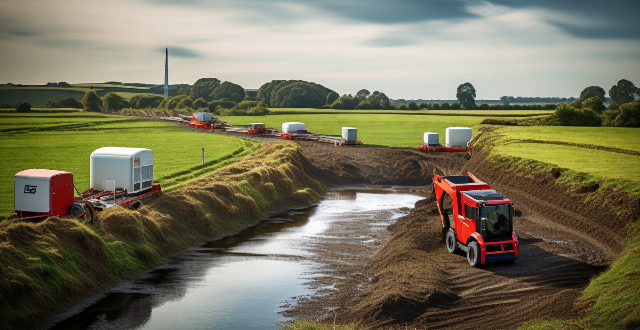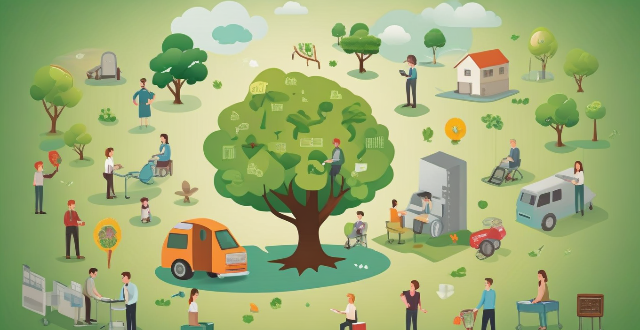Sustainable Reduction

What role does waste reduction play in sustainable development ?
The article discusses the importance of waste reduction in sustainable development. It highlights the environmental, economic, and social benefits of waste reduction, including conservation of natural resources, protection of ecosystems, climate change mitigation, cost savings, job creation, innovation and efficiency, public health, education and awareness, and community engagement. The article emphasizes that waste reduction is an essential component of sustainable development and encourages individuals, businesses, and governments to take action to reduce waste.

How does waste reduction contribute to a circular economy ?
The transition to a circular economy is significantly influenced by waste reduction, which encompasses various strategies like reusing products, recycling materials, and promoting resource efficiency. These practices help in conserving natural resources, reducing pollution, creating economic opportunities, and fostering sustainable consumer behavior. Governments and businesses play a crucial role in driving waste reduction through policy initiatives, technological innovations, and sustainable supply chain management. Community engagement and public awareness further support this shift towards a more sustainable economic model.

How can businesses implement waste reduction practices in their operations ?
This topic discusses the importance of waste reduction in businesses and provides strategies for implementing sustainable practices. It emphasizes the benefits of conducting a waste audit, adopting eco-friendly packaging, optimizing manufacturing processes, promoting reuse and repair, training employees in waste reduction, and partnering with green suppliers. The goal is to contribute to a more sustainable future while also benefiting financially through cost savings and efficiency gains.

What is the relationship between climate finance and disaster risk reduction ?
Climate finance and disaster risk reduction are interconnected concepts that address the impacts of climate change. Climate finance provides funding for projects aimed at reducing greenhouse gas emissions and adapting to climate change, while disaster risk reduction involves strategies to minimize the potential impacts of natural disasters on communities and infrastructure. The relationship between the two lies in their shared goal of addressing climate change, with climate finance supporting disaster risk reduction through funding for adaptation measures, investments in vulnerable communities, promoting sustainable development, encouraging innovation, and strengthening institutional capacity.

What is the relationship between waste reduction and energy conservation ?
The article discusses the relationship between waste reduction and energy conservation, highlighting their importance in promoting sustainable development. Waste reduction strategies such as recycling, composting, reusing materials, and reducing packaging conserve natural resources, reduce landfill space, and lower greenhouse gas emissions. Energy conservation measures like using energy-efficient appliances, improving insulation, and promoting renewable energy sources lead to lower energy costs, reduced greenhouse gas emissions, and promote sustainable development. The practices are interconnected, with recycling saving energy, composting reducing energy use, reducing packaging saving energy, energy-efficient appliances reducing waste, and promotion of renewable energy sources conserving energy and reducing waste.

How do cultural factors influence waste reduction practices ?
The text provides an overview of how cultural factors influence waste reduction practices, highlighting the role of cultural attitudes, social norms, education, religious beliefs, economic conditions, and technological advancements in shaping waste management behaviors. It emphasizes that respect for resources, consumerism vs. conservatism, composting traditions, public awareness campaigns, community cleanliness standards, taboos around waste, environmental education, family values, role models, stewardship principles, reincarnation beliefs, interconnectedness philosophies, affordability of disposable products, recycling costs, government incentives, access to technology, digital awareness campaigns, and innovative product design are all aspects of culture that can significantly impact waste reduction efforts. By understanding these cultural dynamics, more effective strategies for sustainable living can be developed globally.

Are there any laws or regulations aimed at promoting waste reduction ?
Laws and regulations aimed at promoting waste reduction include extended producer responsibility (EPR), landfill taxes and bans, recycling targets, packaging regulations, local ordinances and programs such as curbside recycling and composting, waste reduction education campaigns, pay-as-you-throw programs, and international agreements like the Basel Convention. These measures encourage sustainable practices, reduce waste production, and promote recycling.

Can waste reduction lead to cost savings for individuals and companies ?
Waste reduction can lead to cost savings for both individuals and companies by minimizing waste in various aspects of daily life and business operations. For individuals, reducing food waste through meal planning and proper storage, minimizing energy consumption with energy-efficient appliances and water conservation, and reducing unnecessary spending through secondhand shopping and repairing instead of replacing can result in significant cost savings. Companies can also benefit from waste reduction by optimizing production processes with lean manufacturing techniques and resource recovery, improving logistics and supply chain management through just-in-time inventory and efficient packaging, and enhancing energy efficiency with green building design and employee training. Overall, waste reduction is a crucial aspect of sustainable living and business practices that can lead to cost savings while contributing to environmental sustainability.

Can you explain the myth of spot reduction in fitness ?
Spot reduction, the idea of targeting specific areas for fat loss through exercise, is a myth debunked by scientific research. To achieve desired body composition, focus on total body workouts, maintain a healthy calorie deficit, increase cardiovascular activity, strength train regularly, and be patient and consistent.

How can we promote sustainable development to reduce the risk of climate conflicts ?
Sustainable development is crucial for reducing the risk of climate conflicts. To promote it, we can increase awareness and education, promote renewable energy sources, implement sustainable agriculture practices, invest in green infrastructure, encourage waste reduction and recycling, and collaborate with governments and NGOs.

What role do individuals play in achieving the goals of energy conservation and emission reduction policies ?
The article discusses the critical role of individuals in achieving energy conservation and emission reduction policies. It emphasizes the importance of individual action, highlighting the collective impact of small changes and the potential for behavioral change. The article provides various ways individuals can contribute, such as reducing energy consumption, reducing waste, supporting renewable energy, and advocating for change. It concludes by emphasizing the power of individuals to bring about change and safeguard the planet for future generations.

What is the importance of sustainable agriculture in achieving the Sustainable Development Goals ?
Sustainable agriculture is crucial for achieving the United Nations' Sustainable Development Goals by ensuring food security, improving rural livelihoods, and protecting the environment. It promotes soil health, increases crop yields, encourages biodiversity, creates jobs in rural areas, enhances income, promotes gender equality, reduces greenhouse gas emissions, conserves water resources, prevents land degradation, supports climate change mitigation and adaptation, stimulates economic growth, and reduces poverty. By adopting sustainable agriculture practices, we can create a more equitable and resilient world for future generations.

What is the impact of renewable energy on emission reduction goals ?
The shift to renewable energy sources such as solar, wind, hydro, and geothermal power is vital for reducing greenhouse gas emissions and achieving global emission reduction goals. This transition brings multiple benefits including decreased reliance on fossil fuels, improved air quality, enhanced energy security, economic stimulation through job creation and long-term cost savings, technological innovation leading to reduced costs, and significant contributions to mitigating climate change. As technology advances and economies of scale are achieved, renewable energy's role in facilitating further progress toward emission reduction objectives will become increasingly important.

How can climate services help in disaster risk reduction ?
Climate services play a crucial role in disaster risk reduction by providing essential information and tools that help communities, governments, and businesses to anticipate and respond to the impacts of climate change. These services encompass a range of activities, including weather forecasting, climate monitoring, and the development of early warning systems. Climate services contribute to disaster risk reduction through several strategies, including risk assessment, preparedness planning, early warning and response, and recovery and resilience building. By leveraging these services, societies can build resilience against the increasing challenges posed by a changing climate.

What impact does sustainable investing have on the environment ?
##Impact of Sustainable Investing on the Environment Sustainable investing, also known as responsible or green investing, is an investment strategy that focuses on companies and projects that have a positive impact on the environment and society. This type of investing has become increasingly popular in recent years as investors become more aware of the environmental and social impacts of their investments. The following are some of the ways sustainable investing can have a positive impact on the environment: ### Reduction in Carbon Emissions One of the most significant impacts of sustainable investing is the reduction in carbon emissions. Companies that prioritize sustainability often use renewable energy sources such as solar, wind, and hydro power to generate electricity. This reduces their reliance on fossil fuels, which are major contributors to greenhouse gas emissions. By investing in these companies, investors can help reduce carbon emissions and combat climate change. ### Conservation of Natural Resources Sustainable investing also promotes the conservation of natural resources. Companies that prioritize sustainability often implement practices that reduce waste, conserve water, and protect biodiversity. For example, they may use recycled materials in their products or implement water-saving technologies in their operations. By investing in these companies, investors can help conserve natural resources and protect ecosystems. ### Promotion of Clean Energy Sustainable investing encourages the development and adoption of clean energy technologies. Companies that prioritize sustainability often invest in research and development of new clean energy technologies such as electric vehicles, battery storage systems, and smart grids. By investing in these companies, investors can help drive innovation and accelerate the transition to a low-carbon economy. ### Support for Environmental Regulations Finally, sustainable investing supports the implementation of environmental regulations and policies. Companies that prioritize sustainability often comply with strict environmental regulations and support policies that promote sustainability. By investing in these companies, investors can help create a regulatory environment that encourages businesses to operate sustainably and protect the environment.

How does resource-efficient utilization contribute to sustainable development ?
Resource-efficient utilization is key to sustainable development, conserving resources, reducing waste, and promoting economic growth. It helps mitigate environmental impact, provides economic benefits, and enhances social well-being. As we face global challenges like climate change and resource scarcity, adopting resource-efficient practices is crucial for a sustainable future.

What impact does ESG have on sustainable development goals (SDGs) ?
ESG (Environmental, Social, and Governance) is a set of criteria used by investors to screen potential investments based on their environmental, social, and governance performance. The United Nations' Sustainable Development Goals (SDGs) are a universal call to action to end poverty, protect the planet, and ensure that all people enjoy peace and prosperity. This article explores how ESG can impact achieving the SDGs in terms of reducing carbon emissions, protecting natural resources, reducing poverty, promoting gender equality, improving transparency and accountability, and ensuring access to justice. Incorporating ESG criteria into investment decisions can support projects that contribute to sustainable development and help achieve the SDGs.

What are the most effective strategies for waste reduction in households ?
Effective Strategies for Waste Reduction in Households 1. Reduce: Buy only what you need, choose products with less packaging, and use reusable items. 2. Reuse: Donate or sell unwanted items and repurpose old items for new uses. 3. Recycle: Separate recyclable materials, know what can be recycled locally, and compost organic waste. 4. Avoid Single-Use Plastics: Bring your own reusable bags and use refillable containers. 5. Educate Yourself and Others: Learn about waste reduction and share tips with friends and family.

What is sustainable development and why is it important ?
Sustainable development is a concept that aims to meet the needs of the present without compromising future generations' ability to meet their own needs. It is crucial for addressing poverty, inequality, climate change, and environmental degradation. Sustainable development promotes economic growth, social inclusion, and environmental protection. It encourages renewable energy use, sustainable agriculture, and green technologies to create job opportunities and reduce unemployment. By ensuring access to basic services, it helps reduce poverty and improve living standards for all segments of society. Promoting gender equality is an integral part of sustainable development. It also focuses on reducing greenhouse gas emissions, adapting to climate change, conserving forests, protecting biodiversity and natural resources, controlling pollution, preventing conflicts over resources, aiding in post-conflict recovery, and reducing disaster risks. Sustainable development offers a framework for addressing complex global challenges while ensuring long-term ecological sustainability.

How can climate data analysis inform sustainable development goals and practices ?
**Summary:** Climate data analysis is crucial for understanding environmental systems and shaping sustainable development goals (SDGs) and practices. It helps identify trends, inform policy decisions, assess environmental impacts, and guide sustainable agriculture, urban planning, and disaster risk reduction. By integrating climate data into development frameworks, we can ensure that current actions do not compromise future generations' ability to meet their needs and aspirations.

How does sustainable investing work ?
Sustainable investing, also known as responsible or impact investing, involves making investment decisions based on environmental, social, and governance (ESG) criteria. The goal is to generate long-term financial returns while also considering the broader impact of investments on society and the environment. Here's how sustainable investing works: 1. Identify ESG Criteria: The first step in sustainable investing is to identify the ESG criteria that align with your values and risk tolerance. This could include factors such as carbon emissions, labor practices, diversity, board composition, and more. 2. Screen Investments: Once you have identified your ESG criteria, you can screen potential investments to ensure they meet your standards. This can be done through negative screening (excluding companies that don't meet certain criteria) or positive screening (selecting companies that exceed certain criteria). 3. Integrate ESG into Investment Process: Sustainable investing goes beyond simply screening investments; it involves integrating ESG considerations into the entire investment process. This includes researching companies' ESG performance, engaging with them to encourage improvements, and monitoring their progress over time. 4. Measure Performance: Like any investment strategy, it's important to measure the performance of your sustainable investments. This includes tracking financial returns as well as evaluating the impact of your investments on society and the environment. 5. Rebalance and Review: Finally, sustainable investing requires ongoing monitoring and rebalancing of your portfolio to ensure it continues to align with your ESG criteria and financial goals. This may involve selling off underperforming investments or reallocating funds to new opportunities that better meet your standards.

How does climate governance affect sustainable development goals ?
Climate governance plays a pivotal role in shaping the achievement of sustainable development goals (SDGs). The interconnectedness between environmental preservation and socio-economic advancement necessitates a comprehensive understanding of how climate policies and actions influence the broader spectrum of global development objectives. ## **Impact on Individual SDGs** ### *Goal 2: Zero Hunger* Climate governance directly influences food security by addressing factors such as droughts, floods, and temperature fluctuations that can disrupt agricultural productivity. Effective climate policies can help to: - Ensure stable crop yields through improved irrigation systems and drought-resistant crops. - Mitigate the effects of extreme weather conditions on farming communities. - Promote sustainable land use practices to prevent soil degradation. ### *Goal 7: Affordable and Clean Energy* The transition towards renewable energy sources is at the heart of both climate governance and sustainable energy goals. Policies that encourage the adoption of clean energy technologies contribute to: - Reducing greenhouse gas emissions associated with traditional fossil fuel consumption. - Increasing access to electricity in off-grid areas using solar or wind power. - Creating new economic opportunities in the renewable energy sector. ### *Goal 13: Climate Action* This goal is inherently linked to climate governance, as it calls for urgent action to combat climate change and its impacts. Efficient climate policies can lead to: - Implementation of emission reduction strategies. - Enhanced resilience to natural disasters. - Promotion of environmentally friendly industries and jobs. ## **Cross-Cutting Impacts** ### Health and Well-being Climate governance affects public health outcomes by addressing air quality issues and reducing exposure to extreme weather events. This contributes to achieving: - **Goal 3: Good Health and Well-being** by minimizing climate-related health risks. ### Economic Growth Policies that foster green economies and low-carbon development pathways are crucial for: - **Goal 8: Decent Work and Economic Growth** by creating sustainable job opportunities. - **Goal 9: Industry, Innovation, and Infrastructure** through investment in green technology and infrastructure. ### Social Equity Climate governance also has implications for social equity and inclusion, particularly when considering the disproportionate impacts on vulnerable populations: - **Goal 10: Reduced Inequalities** by ensuring that climate adaptation and mitigation efforts do not marginalize already disadvantaged groups. ## **Conclusion** In conclusion, climate governance is an integral component of advancing sustainable development goals. By prioritizing climate action, nations can make strides in eradicating poverty, achieving food security, promoting health and well-being, and fostering economic growth while protecting the planet for future generations. The synergistic relationship between climate governance and the SDGs underscores the necessity for integrated policy approaches that consider environmental sustainability alongside social and economic development.

How can wind energy contribute to a sustainable future ?
Wind energy is a renewable and sustainable source of power that can significantly contribute to a more sustainable future. It offers several benefits including reducing carbon emissions, stimulating economic growth, enhancing energy security, driving technological innovation, compatible land use, community engagement, scalability, improving health impacts, and promoting education and awareness. By incorporating wind energy into our energy mix, we can create a cleaner, healthier, and more sustainable environment for future generations.

How do climate model predictions inform sustainable development goals ?
Climate model predictions are vital for guiding sustainable development goals (SDGs) by providing insights into future climate conditions. They help project future climate scenarios, assess risks and vulnerabilities, support policy decisions, promote cross-sectoral collaboration, and enhance public awareness. By using these predictions, policymakers can make informed decisions that promote sustainability and resilience, contributing to the achievement of the United Nations' 2030 Agenda for Sustainable Development.

What role do governments play in promoting sustainable development ?
The article discusses the various ways governments can contribute to sustainable development, including leadership and policy-making, education and awareness, infrastructure and investment, regulation and enforcement, and collaboration and partnership. Governments are responsible for setting national policies and priorities that guide the actions of their citizens and businesses, promoting sustainable development through education and public awareness campaigns, investing in infrastructure projects that support environmental protection, energy efficiency, and renewable energy sources, enforcing existing laws and regulations related to environmental protection, resource management, and social equity, and working together with other levels of government, the private sector, civil society, and international organizations to achieve common sustainability goals.

What role does climate-smart technology play in sustainable development goals (SDGs) ?
Climate-smart technology plays a crucial role in achieving the Sustainable Development Goals (SDGs) by mitigating climate change, promoting sustainable agriculture, and supporting economic growth while protecting the environment. It can help reduce poverty by providing access to clean energy, improve agricultural productivity and resilience, improve public health by reducing air pollution, achieve affordable and clean energy, and directly contribute to climate action through the reduction of greenhouse gas emissions and adaptation to the impacts of climate change. Additionally, it can enhance other SDGs indirectly by promoting sustainable practices across various sectors.

How can we encourage more sustainable packaging practices to reduce plastic pollution ?
Encouraging more sustainable packaging practices is crucial in reducing plastic pollution. This can be achieved through education and awareness, regulations and policies, innovation and research, and consumer choices. By raising public awareness, implementing stricter regulations, investing in research and development, and making conscious choices, we can create a more sustainable future for our planet.

Can sustainable fishing practices help mitigate the effects of climate change on the environment ?
Sustainable fishing practices are crucial for mitigating the effects of climate change on the environment. These practices aim to conserve marine ecosystems, reduce carbon emissions from fisheries, promote responsible consumption, maintain biodiversity, enhance carbon sequestration, and promote ecosystem-based management. By adopting sustainable fishing practices, we can help maintain the health and balance of our oceans in the face of climate change. As individuals and communities, we must support these practices and make responsible choices when consuming seafood products to protect our planet's delicate ecosystems and ensure a sustainable future for all.

How can we create a sustainable economy that benefits both people and the planet ?
To create a sustainable economy that benefits both people and the planet, several strategies must be employed. These include shifting to renewable energy sources, promoting circular economy practices, encouraging green innovations and technology, implementing sustainable agriculture practices, supporting local economies and fair trade, and raising awareness and education about sustainability. By taking these steps, we can ensure the well-being of current and future generations while minimizing waste, reducing environmental impacts, and conserving natural resources.

How can citizens engage with businesses to promote more sustainable practices ?
The article discusses the crucial role of citizens in promoting sustainable practices within businesses. It offers a detailed guide on how individuals can engage with companies to drive change and foster a more sustainable future. The suggested strategies include educating oneself about sustainability issues, supporting sustainable brands, engaging in dialogue with businesses, participating in campaigns initiated by NGOs or other organizations, using social media to raise awareness, providing feedback to businesses, advocating for policies that support sustainability, and starting conversations about sustainability among peers. By employing these strategies, citizens can effectively engage with businesses and promote more sustainable practices.